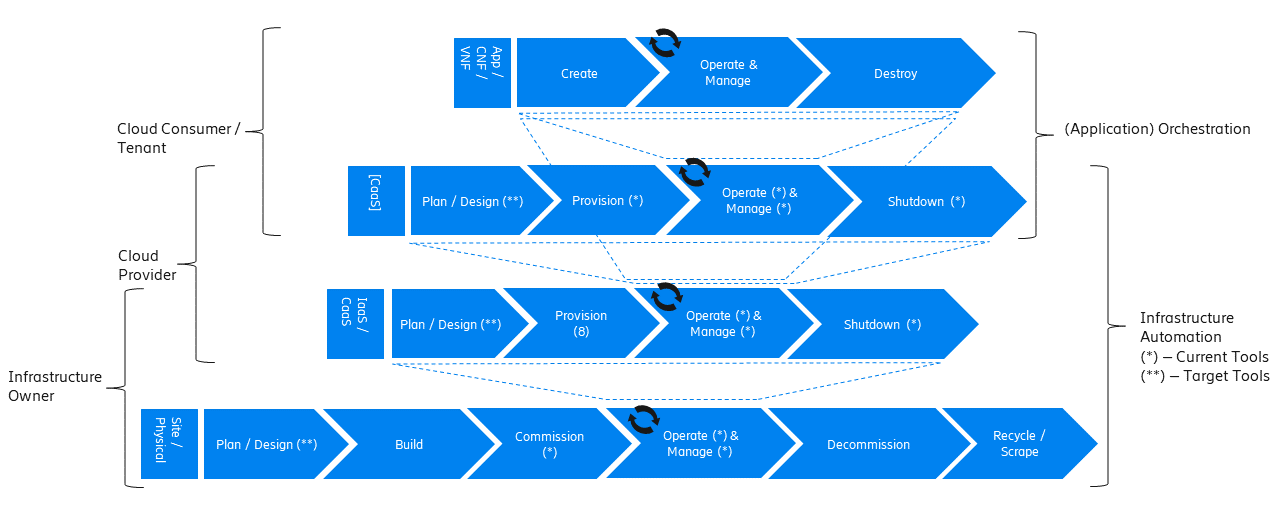In a typical telecom operator environment, infrastructure Life Cycle Management is highly complex and error-prone. The environment, with its multiple vendors and products, is maintenance expensive (both time and costs) because of the need for complex planning, testing, and the out-of-business-hours execution required to perform disruptive maintenance (e.g., upgrades) and to mitigate outages to mission-critical applications. Processes and tooling for infrastructure management across hybrid environments create additional complexity due to the different levels of access to infrastructure: hands-on access to the on-premise infrastructure but only restricted access to consumable services offered by public clouds.
Life cycle operations, such as software or hardware upgrades (including complex and risky firmware updates), typically involve time-consuming manual research and substantive testing to ensure that an upgrade is available, required, or needed, and does not conflict with the current versions of other components. In a complex and at-scale Hybrid Multi-Cloud environment, consisting of multiple on-premise and public clouds, such a manual process is ineffective and, in many cases, impossible to execute in a controlled manner. Hence, the need for automation.
The goals of LCM are to provide a reliable administration of a system from its provisioning, through its operational stage, to its final retirement. Key functions of Infrastructure LCM:
- Hybrid, Multi-Cloud support, that is, LCM works across physical, virtual, and cloud environments, supporting on-premise, cloud, and distributed environments (like Edge)
- Complete system life cycle control (Plan/Design, Build, Provision, Operate/Manage, Retire, Recycle/Scrap)
- Enablement for automation of most system maintenance tasks
The following diagrams provide mapping between different stages of the lifecycle automation across all layers of the stack to owners of infrastructure and cloud and the tenant as the consumer of the cloud services in three very different scenarios: applications running as containers within virtual machines (CaaS on IaaS scenario), application running as containers on bare metal (CaaS on BM scenario) and more traditional view of applications running as VNFs within virtual machines (IaaS scenario) . The diagrams define the scope of the Infrastructure LCM Automation for each of these scenarios. The dotted lines symbolise the interactions between the layers of each of the model .
Essential foundation functional blocks for Infrastructure LCM automation:
- Representation Model
- Repository functions
- Available Software Versions and Dependencies
- Orchestration Engine
Automated LCM uses Representation Model to:
- abstract various automation technologies
- promote evolution from automation understood as automation of human tasks to autonomous systems using intent-based, declarative automation, supported by evolving AI/ML technologies
Automated LCM uses Repository functions to:
- store and manage configuration data
- store and manage metrics related data such as event data, alert data, and performance data
- maintain currency of data by the use of discovery of current versions of software modules
- track and account for all systems, assets, subscriptions (monitoring)provide an inventory of all virtual and physical assets
- provide a topological view of interconnected resources
- support network design function
Automated LCM uses available IAC Software Versions and Dependencies component to:
- store information about available software versions, software patches and dependency expectations
- determine the recommended version of a software item (such as firmware) and dependencies on other items in the node to ensure compliance and maintain the system integrity
- determine the recommended versions of foundation software running on the cluster
Automated LCM uses Orchestration Engine to:
- take the inputs from Repositories, Available Software Versions, and Dependencies
- run the software version changes
- dynamically remediate dependencies during the change process to optimise outcome
- ensure that the system is consistent across its life cycle by maintaining it in accordance with the intent templates
